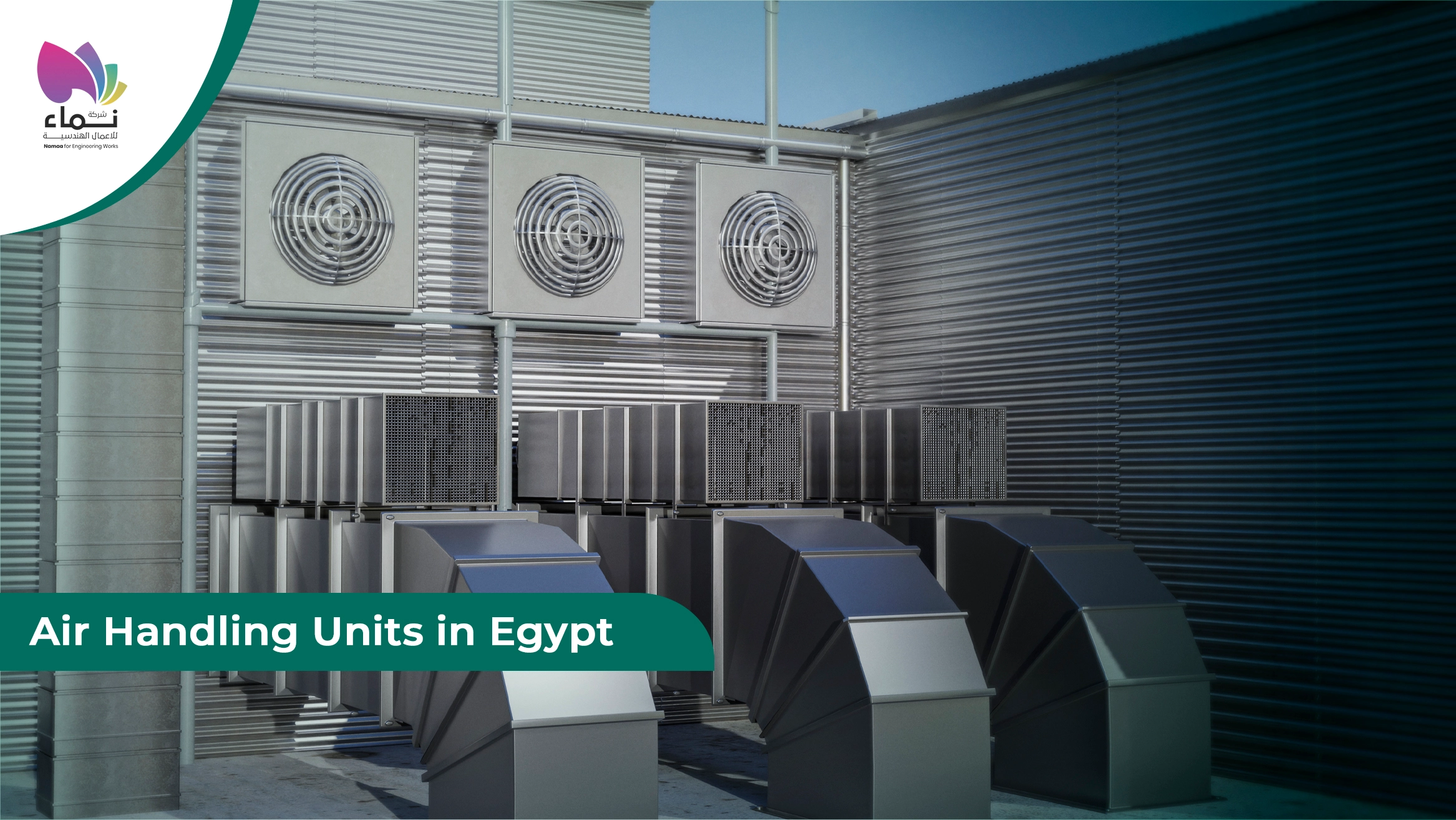Air Handling Units in Egypt (AHUs) play a crucial role in heating, ventilation, and air conditioning (HVAC) systems, ensuring the circulation of clean and conditioned air within buildings. These units are essential for maintaining indoor air quality and comfort levels in various environments, including residential, commercial, and industrial spaces.
Definition of Air Handling Units
Air Handling Units in Egypt (AHUs) are integral components of heating, ventilation, and air conditioning (HVAC) systems. They are responsible for regulating and circulating air within buildings, ensuring a comfortable and healthy indoor environment. AHUs typically consist of components such as filters, fans, heating and cooling coils, dampers, and controls. These units are designed to control temperature, humidity, and air quality by conditioning the incoming air before distributing it throughout the building.
Importance of Air Handling Units in Egypt
In Egypt, where extreme heat and arid climates are prevalent, the importance of Air Handling Units in Egypt (AHUs) cannot be overstated. These units play a vital role in maintaining indoor comfort levels and ensuring the well-being of occupants in various settings, including residential, commercial, and industrial buildings.
Types of Air Handling Units
Air Handling Units in Egypt (AHUs) come in various types, each designed to meet specific requirements and applications. Understanding the different types of AHUs is essential for selecting the most suitable option for a particular HVAC system. Here are three common types of Air Handling Units:
-
Single-Zone Air Handling Units
Single-Zone Air Handling Units are designed to serve a single space or zone within a building. These units typically supply conditioned air at a constant volume and temperature to maintain consistent comfort levels within the designated area.
-
Multi-Zone Air Handling Units
Multi-Zone Air Handling Units are capable of serving multiple spaces or zones within a building independently. These units feature separate air distribution pathways and controls for each zone, allowing for precise temperature and airflow control based on individual requirements.
-
Variable Air Volume (VAV) Air Handling Units
Variable Air Volume (VAV) Air Handling Units are designed to adjust the volume of conditioned air supplied to different zones based on their heating and cooling needs. These units incorporate variable speed fans and dampers that modulate airflow in response to changing load conditions, maximizing energy efficiency and comfort.
Components of Air Handling Units
Air Handling Units in Egypt (AHUs) consist of various components working together to regulate and distribute conditioned air throughout buildings. Understanding the function of each component is essential for ensuring the efficient operation of the AHU. Here are some key components commonly found in AHUs:
- Fans
Fans play a crucial role in the AHU by circulating air through the unit and distributing it to different zones within the building. These fans can be centrifugal or axial, depending on the design and requirements of the AHU.
- Filters
Filters are installed in the AHU to remove airborne particles, dust, pollen, and other contaminants from the incoming air before it is distributed into the building.
- Heating and Cooling Coils
Heating and cooling coils are responsible for conditioning the air by either heating or cooling it before it is supplied to the building spaces. These coils typically consist of finned tubes through which hot water, steam, chilled water, or refrigerant flow to transfer heat to or from the air passing over them.
- Dampers
Dampers are devices used to control the flow of air within the AHU and the distribution system.
Sizing and Selection of Air Handling Units
Proper sizing and selection of Air Handling Units in Egypt (AHUs) are crucial steps in designing an HVAC system that meets the specific needs and requirements of a building. This process involves determining airflow requirements, calculating cooling and heating loads, and selecting the appropriate AHU size. Here’s an overview of each step:
-
Determining Airflow Requirements
The first step in sizing an AHU is to determine the airflow requirements for the building or space it will serve. This involves considering factors such as the size of the area, occupancy levels, ventilation standards, and any special requirements for air quality or comfort.
-
Calculating Cooling and Heating Loads
Once the airflow requirements are determined, the next step is to calculate the cooling and heating loads for the building. Cooling loads are influenced by factors such as outdoor temperature, solar heat gain, internal heat sources (e.g., equipment, lighting, occupants), and building envelope characteristics (e.g., insulation, windows).
-
Selecting the Appropriate Air Handling Unit Size
Based on the determined airflow requirements and calculated cooling and heating loads, the final step is to select the appropriate size and configuration of the AHU.
Installation and Maintenance of Air Handling Units
Proper installation and regular maintenance are essential for ensuring the optimal performance, efficiency, and longevity of Air Handling Units in Egypt (AHUs). This includes considerations such as proper placement and mounting, ductwork connection and sealing, regular cleaning and filter replacement, and inspection and lubrication of fan motors. Here’s a closer look at each aspect:
-
Proper Placement and Mounting
During installation, it’s crucial to place and mount the AHU in a location that allows for adequate airflow and accessibility for maintenance. The unit should be positioned on a level surface, away from obstructions and sources of heat or vibration. Proper clearance should be maintained around the AHU to ensure unrestricted airflow and service access.
-
Ductwork Connection and Sealing
Proper ductwork connection and sealing are essential for ensuring efficient airflow and preventing air leaks in the HVAC system. All ductwork connections to the AHU should be properly sealed to minimize air leakage and maintain the desired air distribution within the building.
-
Regular Cleaning and Filter Replacement
Regular cleaning and filter replacement are critical maintenance tasks that help maintain indoor air quality and prevent the buildup of contaminants within the AHU. Filters should be inspected regularly and replaced as needed to ensure optimal airflow and filtration efficiency.
-
Inspection and Lubrication of Fan Motors
Fan motors are integral components of AHUs and require regular inspection and lubrication to ensure smooth and efficient operation. During routine maintenance, fan motors should be inspected for signs of wear, damage, or malfunction.
Energy Efficiency of Air Handling Units
Enhancing the energy efficiency of Air Handling Units (AHUs) is crucial for reducing operational costs, minimizing environmental impact, and meeting sustainability goals. Several energy-saving technologies and strategies can be implemented to improve the efficiency of AHUs, including energy recovery systems, variable speed drives, and demand control ventilation. Here’s how each contributes to energy efficiency:
-
Energy Recovery Systems
Energy recovery systems, such as heat exchangers or heat recovery wheels, capture and reuse energy from exhaust air to pre-condition incoming fresh air. By transferring heat or cooling energy between the outgoing and incoming airstreams, energy recovery systems help reduce the workload on heating and cooling equipment, thereby lowering energy consumption and operating costs.
-
Variable Speed Drives
Variable speed drives (VSDs) allow AHU fans and motors to operate at variable speeds based on load demand, rather than running at constant speeds. By adjusting the fan speed to match the required airflow, VSDs can significantly reduce energy consumption and improve system efficiency, especially during part-load conditions.
-
Demand Control Ventilation
Demand control ventilation (DCV) systems adjust ventilation rates based on occupancy levels and indoor air quality requirements, rather than operating at a fixed airflow rate. By monitoring CO2 levels or occupancy sensors, DCV systems can modulate the supply of fresh air to match actual occupancy, reducing over-ventilation during periods of low occupancy and minimizing energy waste.
Regulations and Standards for Air Handling Units
Ensuring compliance with relevant regulations and standards is essential when designing, installing, and operating Air Handling Units in Egypt. This includes adherence to Egyptian building codes and regulations as well as international standards such as those established by ASHRAE. Here’s an overview of the regulations and standards applicable to AHUs in Egypt:
- Egyptian Building Codes and Regulations
Egyptian building codes and regulations govern various aspects of construction, including HVAC systems and ventilation requirements. These codes outline minimum standards for building design, construction, and operation to ensure safety, health, and environmental sustainability.
- ASHRAE Standards for Air Handling Units
The American Society of Heating, Refrigerating, and Air-Conditioning Engineers (ASHRAE) develops and publishes standards and guidelines for the design, installation, operation, and maintenance of HVAC systems, including AHUs.
Common Issues and Troubleshooting
Air Handling Units in Egypt may encounter various issues during operation that can affect indoor air quality, airflow, and overall performance. Identifying and troubleshooting these common issues promptly is essential for maintaining optimal system operation and occupant comfort. Here are some common issues and troubleshooting steps:
- Poor Air Quality
Troubleshooting Steps:
- Check Filters
- Inspect Coils
- Address Ventilation Issues
- Eliminate Odors
- Inadequate Airflow
Troubleshooting Steps:
- Check Fan Operation
- Inspect Dampers
- Clear Obstructions
- Balance Airflow
- Noisy Operation
Troubleshooting Steps:
- Inspect Fan Blades
- Check Motor Mounting
- Inspect Ductwork
- Install Sound Attenuation
Future Trends in Air Handling Units
As technology continues to evolve, Air Handling Units (AHUs) are undergoing significant advancements to meet the evolving needs of buildings and occupants. Future trends in AHUs focus on enhancing efficiency, connectivity, and sustainability through the adoption of smart technologies and innovative energy-saving solutions. Here are some key trends shaping the future of AHUs:
1. Smart Air Handling Units
Future Direction:
Smart Air Handling Units equipped with sensors, controllers, and connectivity features are poised to revolutionize the HVAC industry.
Benefits:
-
Real-time monitoring and optimization of indoor air quality and comfort parameters.
-
Predictive maintenance and fault detection capabilities to minimize downtime and repair costs.
-
Remote monitoring and control via cloud-based platforms for enhanced accessibility and convenience.
-
Integration with smart building management systems for seamless operation and energy management.
2. Integration with Building Automation Systems
Future Direction:
Integration of Air Handling Units with Building Automation Systems (BAS) enables centralized control, coordination, and optimization of HVAC systems within
Buildings.
Benefits:
-
Centralized control and coordination of HVAC systems for improved efficiency and comfort.
-
Dynamic optimization of AHU operation based on real-time data and building occupancy.
-
Seamless integration with other building systems, such as lighting, security, and occupancy sensors.
-
Enhanced energy management and cost savings through demand-based control strategies.
3. Advances in Energy Efficiency Technologies
Future Direction:
Continued advancements in energy efficiency technologies are driving innovation in AHU design and operation.
Benefits:
-
Improved energy efficiency and reduced operational costs through advanced technologies and control strategies.
-
Integration of energy recovery systems to capture and reuse waste heat or cooling energy.
-
Optimization of fan and motor performance using variable speed drives and advanced control algorithms.
-
Enhanced thermal comfort and indoor air quality while minimizing environmental impact.
Air Handling Units in Egypt
Air Handling Units in Egypt play a pivotal role in ensuring optimal indoor air quality and comfort, especially in regions like Egypt with its unique climate challenges. Namma Company stands out as a trusted provider of high-quality AHUs, offering tailored solutions to meet the diverse needs of clients across Egypt.
In conclusion, Namma Company emerges as a trusted partner for Air Handling Units in Egypt, offering top-of-the-line Air Handling Units characterized by innovation, quality, and reliability. With a commitment to customer satisfaction and a track record of excellence, Namma stands poised to address the evolving HVAC needs of the Egyptian market effectively.
By choosing Namma’s Air Handling Units can enjoy superior performance, energy efficiency, and reliability, ensuring optimal indoor environments and comfort for occupants across various sectors.
FAQs
What are the maintenance requirements for AHUs?
Regular maintenance, including filter replacement and coil cleaning, is essential to ensure optimal performance and longevity of AHUs. Namma provides detailed maintenance guidelines to help customers keep their units in top condition.
Can Namma's AHUs be customized for specific industrial applications?
Yes, Namma offers customizable options to tailor AHU configurations according to the unique requirements of different industries, ensuring optimal performance and efficiency.
Are Namma's AHUs suitable for extreme weather conditions?
Yes, Namma's AHUs are designed to withstand a wide range of environmental conditions, including extreme heat, humidity, and dust, making them ideal for use in challenging climates like Egypt.




